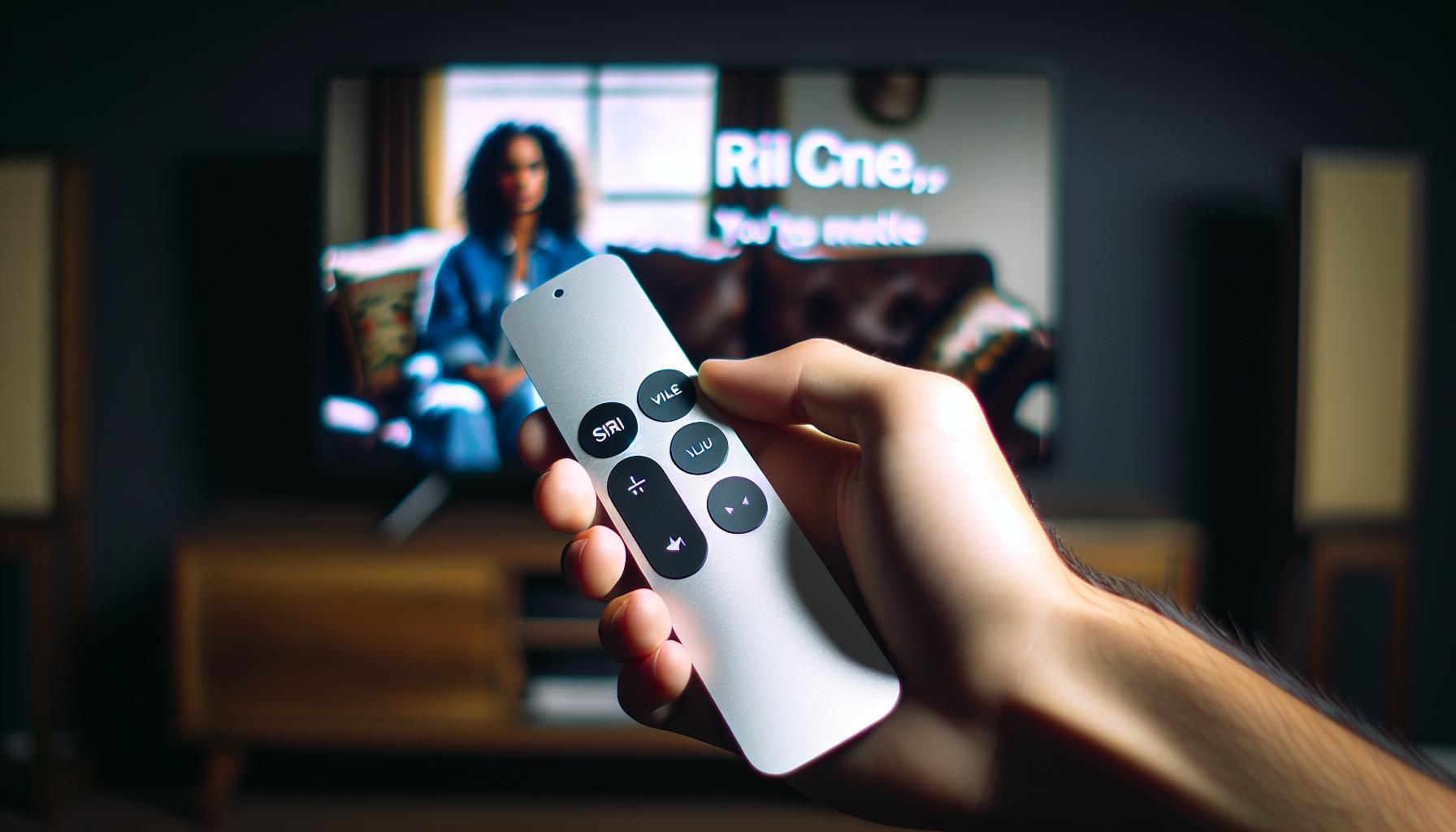Ever found yourself holding an Apple TV remote, feeling a bit lost? Don't worry, you're not alone. It's a common predicament for new users, but we're here to help. In this guide, you'll learn how to navigate your Apple TV remote like a pro.
Apple TV remotes are sleek and minimalist, but they pack a punch in terms of functionality. Whether you've got the Siri Remote, or the older Apple Remote, understanding how to use it effectively can open up a whole new world of entertainment.
So, let's get started. By the end of this article, you'll be flipping through your favorite shows and apps with ease. Remember, it's not as complicated as it seems, and with a little practice, you'll be an expert in no time.
Ways to identify your Apple TV remote
Ensure you're using the right control for your Apple TV version. Apple has launched numerous versions, each coming with a different set of remote controls. Although there's an underlying parity among them, remember that effectiveness is best derived from knowing the specific characteristics of what you're handling.
Let's venture into three main types you are likely to encounter.
Siri Remote or Apple TV Remote - This sleek and modern remote control accompanies Apple TV 4K and Apple TV HD. It's designed with a touch surface allowing swipe-based navigation. The remote features a Menu, TV, Siri, and Play/Pause button. Moreover, it has volume controls and is equipped with a built-in microphone to cater to Siri commands.
Apple Remote (aluminum or white) - These are conventional remotes that come with the earlier versions of Apple TV. They're white or silver, featuring a simple layout of buttons: Menu, Play/Pause, and a navigation circle with a select button in the middle. Not forgetting two buttons for volume control.
Third-Party Remote Controls - You might also encounter non-Apple branded remotes. With Apple's collaboration, some manufacturers like Universal Electronics offer remote controls for Apple TV. They carry similar functions to the original remote albeit with subtle variations in design.
Check out the table below for a quick comparison:
| Siri Remote / Apple TV Remote | Apple Remote (aluminum or white) | Third-Party Remote Controls | |
|---|---|---|---|
| Color | Black | White or Silver | Varies |
| Buttons | Menu, TV, Siri,Play/Pause, volume control | Menu, Play/Pause, navigation circle, volume control | Depends on the manufacturer |
| Navigation | Touch surface (swipe based) | Directional buttons | Depends on the manufacturer |
| Special Features | Siri button for voice commands | N/A | Depends on the manufacturer |
Recognizing your particular remote type is the first step to becoming proficient at using it. Now, you're equipped with the knowledge necessary to identify your Apple TV remote, ready to explore its capabilities further. Delve deeper and start making the most out of your entertainment experience.
How to turn on your Apple TV remote

After identifying your specific Apple TV remote, it's crucial to know how to power it on effectively. Each remote comes with its own unique procedure. However, for this piece, we're primarily focusing on the Siri Remote and the Apple Remote (aluminum or white).
With the Siri Remote, you don't need to worry about a power button. It's adept at saving energy by going into sleep mode after a period of inactivity. The real game starts when you pick it up. Its built-in accelerometer and gyroscope spring it into action the moment you move it. The touch surface on the top half will light up your Apple TV when you swipe or press. Nifty isn't it?
On the other hand, the Apple Remote (aluminum or white) is as straightforward as they come. Check for a circular button towards the top with a distinctive 'menu' inscription. Simply clicking this button will breathe life into your TV.
Use the following table to quickly compare activating your specific remote:
| Apple TV Remote Type | Activation Method |
|---|---|
| Siri Remote | Motion-activated or touch surface interaction |
| Apple Remote | Click the 'menu' button |
Yet, remember to pair your remote with the Apple TV device before all else. If it's your first time using the remote, it'll automatically pair itself after you turn on Apple TV. If it doesn't, manual pairing instructions can be found in the Apple TV settings.
Next, we'll explore detailed troubleshooting tips for common issues with Apple TV remote controls. This includes unresponsive touch surfaces, disappearing cursor and more. Whether you're experiencing one of these problems or hoping to avoid them altogether, you'll soon know the ins and outs of smooth Apple TV operation.
Now that you're familiar with turning on and pairing your Apple remote, let's dive deeper into what each button on your remote is capable of. Understanding the buttons on your Apple TV remote is key to maximising the utility of your device. Whether you're using a Siri Remote or an Apple Remote, understanding the function of each button makes for a smoother, richer viewing experience.
Siri Remote is your gateway to a wide range of commands. The top part of your Siri Remote has a Touch surface. Loosely compared to a touchpad on a laptop, you can swipe in all directions to navigate apps and move around within Apple TV's interface. Right below the touch surface, you'll find the Menu button. A click here brings you to the previous screen. Consider it your go-to for backtracking.
On the right of the Menu button, you'll see the TV/Home button. Pressing this button once will send you back to the Home screen. If you're already on the Home screen, pressing the TV/Home button will send you to the Apple TV App. If you press and hold it, you'll see a screen from where you can put Apple TV to sleep, jump to the Home screen, or access search, music, and Airplay controls.
On the lower part of the Siri Remote, you'll find the Play/Pause button. It's fairly self explanatory, allowing you to play or pause content. It's seated between the volume controls on the right and the Siri button on the left.
The Apple Remote, whether aluminum or white, has a slightly different layout. It has six buttons: Menu, Play/Pause, Up, Down, Left and Right. Much like the Siri Remote, the Menu button is your path to the previous screen while Play/Pause controls playback.
Don't be intimidated by all these buttons. They're easy to master and greatly improve your TV viewing experience. So, grab your Apple remote, settle in comfortably, and enjoy the world of entertainment within your reach.
Now that you're familiar with the buttons on your Apple TV remote, let's dive into how you can use them to efficiently navigate the interface.
One of the key aspects of Apple products is their user-friendly design and the Apple TV interface is no exception. Using your Apple TV remote, you can slide your finger on the Touch surface to scroll across menus and apps on your screen. Make the selection process easier by tapping the touch surface instead of clicking it. You are in control of your Apple TV device.
The Menu button is your gateway to accessing multiple features. Tapping it once will take you back to the previous screen. Holding it down for a few seconds will lead you straight to the Apple TV homepage, no matter where you are in the system.
The TV/Home button has dual functions. It doesn't just take you back home with a single press but with a long hold, it can put your device to sleep. This is beneficial for saving power when not in use.
For media manipulation, look no further than the play/pause button. It's your one-stop button for controlling your media viewing experience. A simple press can pause or play your content instantly. But here's a tip, double-clicking it while in the home screen will start playing the most recently viewed content.
To control volume levels, use the volume controls. You don't need to juggle multiple remotes. Your Apple TV remote lets you manipulate the sound for maximum enjoyment.
Navigating your Apple TV interface is an intuitive and efficient experience. Familiarize yourself with these functions and enhance your user experience. The ability to fully manipulate your Apple TV interface is really in your hands.
Tips and tricks for using your Apple TV remote

Now you've got a good understanding of your Apple TV remote's basic functions, let's delve into some cool features you might not be aware of. These savvy techniques cater to a more straightforward and efficient way of navigating your device, enhancing its already user-friendly nature.
An important feature on your Apple TV remote is the Siri button. This function kicks your Apple TV experience up a notch. Press and hold to activate Siri and ask her to find your favorite programs or even check the weather. She's a handy tool for effortless navigation.
Another nifty trick involves the remote's volume buttons. Besides controlling your TV's volume, you might be surprised to find out that you can control your TV's power. That's right, the Apple TV remote can turn your TV on or off when you hold down the volume button. This feature, however, only works if your TV supports HDMI-CEC.
Think about the times you're lounging on your couch, barely able to see your remote in the dim light. Well, here's a helpful solution – the Apple TV remote's backlight feature. The remote's buttons light up when you pick it up, making viewing easier.
Apple TV also offers the ability to create customized shortcuts, providing a tailored experience. By going into the settings, you can assign specific actions to the play/pause button's double-click.
Remember, variety enhances your user experience in any digital interface. The more you explore, the more shortcuts and features you'll unlock with your Apple TV remote. Take the reins and make your Apple TV viewing experience truly your own.
Conclusion
Now that you've got the lowdown on the Apple TV remote, it's time to put that knowledge to use. Remember, the Siri button is your go-to for quick assistance and the volume buttons do more than just adjust sound. Don't forget about the remote's backlight, a small feature that makes a big difference in low light. And, of course, customizing those double-click shortcuts can truly enhance your viewing experience. So, why wait? Grab your Apple TV remote and start exploring these features. You'll soon realize just how much this small device can improve your user experience. Happy viewing!
The Siri button activates Siri, allowing users to ask for help, for instance, with finding programs or checking the weather.
Yes, the volume buttons can control the TV's power, provided your TV supports HDMI-CEC.
What is the unique feature of the remote's backlight?
The remote's backlight lights up the buttons when the remote is picked up, meaning you can use it conveniently even in the dark.
Yes, the remote allows users to create customized shortcuts for the play/pause button's double-click, making it easier to access your favorite functions.
What is the overall message of the article on the Apple TV remote?
The article stresses the importance of exploring and familiarizing oneself with the various features of the Apple TV remote for a personalized and enhancing viewing experience.




